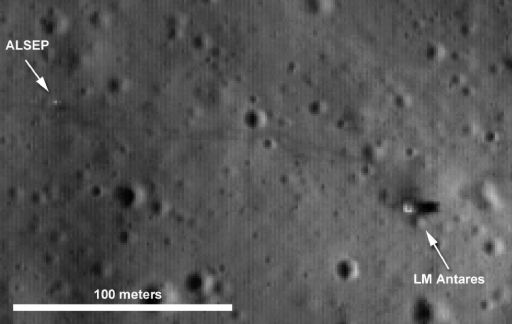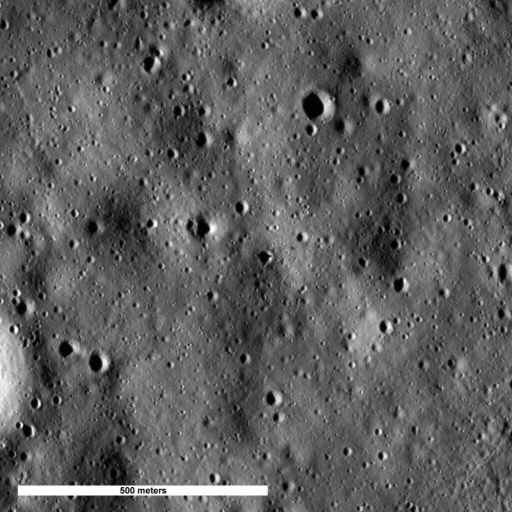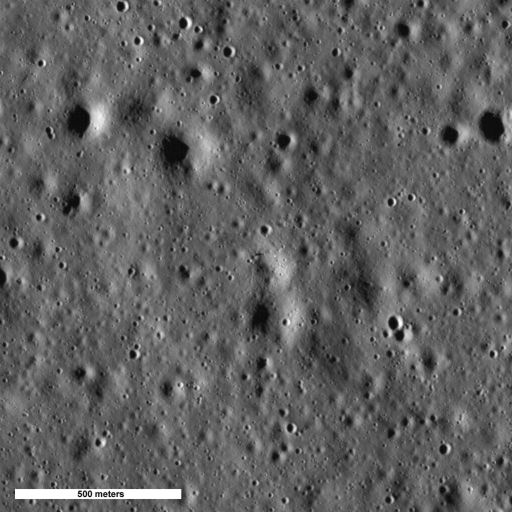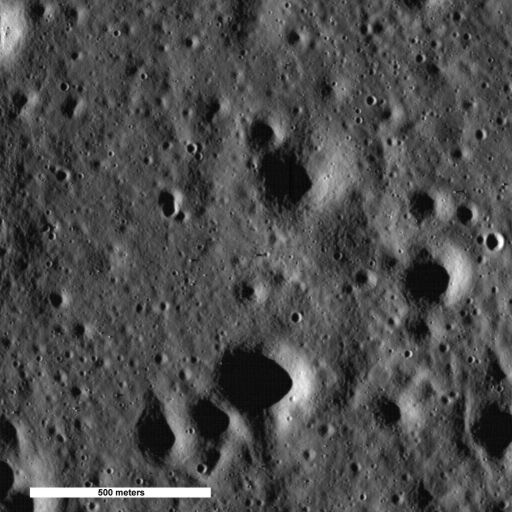Elizabeth "Zibi" Turtle • Jul 17, 2009
LROC images sites of the Apollo landings
by Zibi Turtle

Apollo 14 Landing Site
unar Reconnaissance Orbiter Camera (LROC) image of the Apollo 14 landing site, showing the lunar module (LM) and the Apollo Lunar Surface Experiment Package (ALSEP), instruments which were deployed by the astronauts. Tracks left by the astronauts over 38 years ago can be seen running between the two.
ver the last week, as the Lunar Reconnaissance Orbiterteam's waited impatiently, the Lunar Reconnaissance Orbiter Camera (LROC) has imaged all but one of the Apollo landing sites. The images released today show the sites of Apollo missions 11 and 14 through 17 (the Apollo 12 site will be imaged in the next few weeks).

Apollo 16 Landing Site
pollo 16 lunar module, Orion.
Image width: 256 meters (about 840 ft.) Because LRO's polar orbit initially ran almost along the terminator, in some of the images the ~10-foot high lunar modules have dramatic shadows. Particularly striking is the one the Apollo 16 LM casts on the far wall of the nearby crater.
LRO is currently in an elliptical orbit, so the pixel scales of the images vary somewhat from 1.0 to 1.4 meters (i.e., individual pixels in the images are between 1.0 and 1.4 meters across). By September, the orbit will be made circular and lowered to optimize surface mapping for investigation of potential landing sites for future human exploration of the Moon, at which point the already breathtaking resolution will improve by a factor of 2-3 (to a pixel scale of 0.5 meters).
The full images and much more information are available on the LROC website.
More information about the LRO mission can be found on the NASA and LRO websites.
 Zibi Turtle is a research scientist in the Planetary Exploration group at Johns Hopkins University's Applied Physics Lab. She is an associate of Cassini's imaging team and member of the Lunar Reconnaissance Orbiter Camera team. Her research interests include impact cratering and planetary geology, e.g., lake formation on Titan, crater formation and modification, and mountain building on volcanic Io. When not sitting in front of a computer, she enjoys racing with the Baltimore Rowing Club, taiko, and playing with her nieces.
Zibi Turtle is a research scientist in the Planetary Exploration group at Johns Hopkins University's Applied Physics Lab. She is an associate of Cassini's imaging team and member of the Lunar Reconnaissance Orbiter Camera team. Her research interests include impact cratering and planetary geology, e.g., lake formation on Titan, crater formation and modification, and mountain building on volcanic Io. When not sitting in front of a computer, she enjoys racing with the Baltimore Rowing Club, taiko, and playing with her nieces.
Support our core enterprises
Your support powers our mission to explore worlds, find life, and defend Earth. You make all the difference when you make a gift. Give today!
Donate

 Explore Worlds
Explore Worlds Find Life
Find Life Defend Earth
Defend Earth




